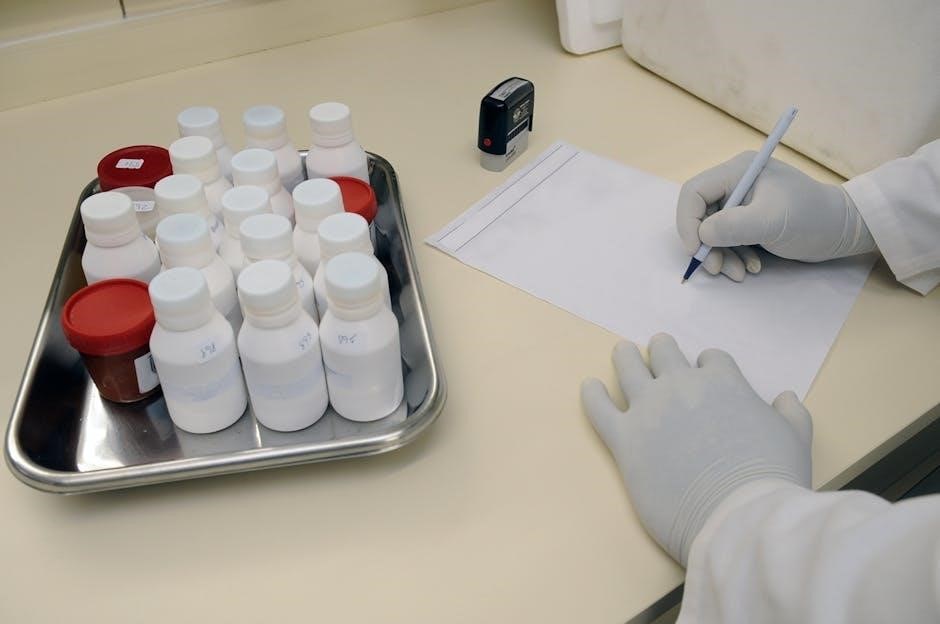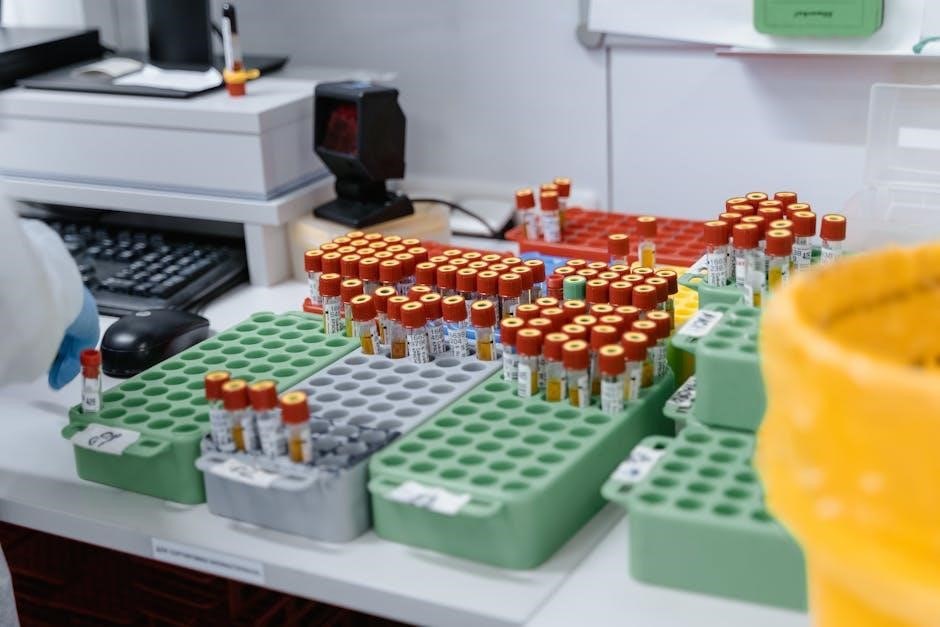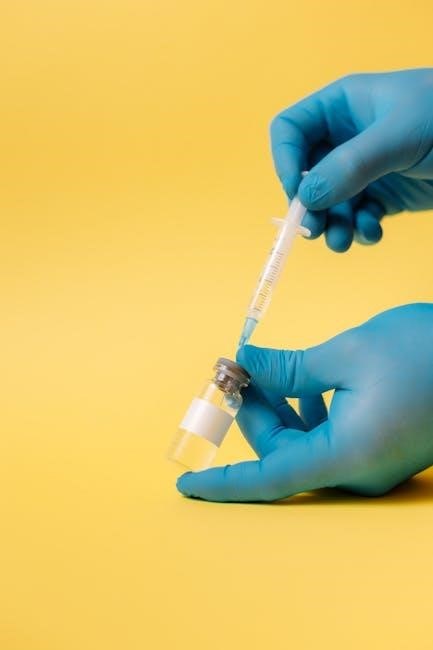Clinical trials are structured studies evaluating medical interventions‚ involving human participants to assess safety‚ efficacy‚ and optimal dosage‚ ensuring regulatory approval and patient safety.
Overview of Clinical Research Phases
Clinical trials are divided into four main phases‚ each serving distinct objectives. Phase 0 involves exploratory studies to assess drug interactions and pharmacokinetics in small groups. Phase I focuses on safety‚ tolerability‚ and dosing in healthy volunteers. Phase II evaluates efficacy and further safety in patient populations‚ while Phase III expands to larger‚ diverse groups to confirm effectiveness and monitor rare side effects. Phase IV involves post-marketing surveillance to assess long-term safety and real-world efficacy. These phases ensure a systematic approach to drug development‚ emphasizing safety‚ efficacy‚ and continuous monitoring. Understanding these phases is crucial for advancing medical interventions and protecting patient well-being throughout the research process.

Importance of Understanding Clinical Trial Phases
Understanding clinical trial phases is crucial for ensuring participant safety‚ advancing medical science‚ and meeting regulatory requirements. Each phase addresses specific questions‚ from initial safety assessments in Phase I to large-scale efficacy evaluations in Phase III and post-marketing surveillance in Phase IV. This structured approach minimizes risks‚ optimizes dosing‚ and ensures treatments are effective before widespread use. For participants‚ awareness of trial phases aids informed consent and realistic expectations. Researchers and sponsors benefit by aligning studies with regulatory standards‚ enhancing transparency‚ and maintaining public trust. Ultimately‚ this systematic process ensures that only safe and effective interventions progress to clinical practice‚ benefiting both individuals and society.

Phase 0: Exploratory Trials
Phase 0 trials involve microdosing to study pharmacokinetics‚ pharmacodynamics‚ and bioavailability‚ providing early insights into drug behavior in humans without therapeutic intent.
Objectives of Phase 0 Studies
Phase 0 studies aim to evaluate the pharmacokinetics‚ pharmacodynamics‚ and bioavailability of investigational drugs in humans. These trials involve microdosing to assess how the drug behaves in the body‚ such as absorption‚ distribution‚ metabolism‚ and excretion. The primary goal is to gather early data on drug activity and tolerability‚ helping to identify promising candidates for further development. Unlike later phases‚ Phase 0 does not focus on therapeutic efficacy but rather on understanding the drug’s fundamental properties. This phase also helps reduce the number of candidates moving to larger‚ more costly trials‚ optimizing resource allocation. By providing critical insights‚ Phase 0 studies accelerate the development process and improve the efficiency of clinical research.

Design and Participant Selection
Phase 0 trials employ a minimalist design‚ typically involving small groups of healthy volunteers. Participants are usually 15-30 individuals‚ often young‚ healthy males‚ to minimize confounding variables. Inclusion criteria focus on age‚ weight‚ and overall health‚ while exclusion criteria may include pre-existing conditions or concurrent medications. The study design emphasizes microdosing‚ using sub-therapeutic doses to evaluate pharmacokinetics. Data collection includes frequent blood sampling and advanced imaging techniques. Ethical considerations and safety monitoring are paramount. This selective approach ensures high-quality data while maintaining participant safety‚ enabling researchers to make informed decisions about advancing the drug to further testing. This phase’s design is optimized for efficiency and precision‚ laying the groundwork for subsequent clinical trials.

Phase I: First-in-Human Trials
Phase I trials are the first stage of testing in humans‚ assessing safety‚ tolerability‚ and pharmacokinetics in a small‚ healthy volunteer group under close medical supervision.
Primary Objectives of Phase I
The primary objectives of Phase I trials are to evaluate the safety‚ tolerability‚ and pharmacokinetics of an investigational drug in healthy volunteers. These studies determine the maximum tolerated dose‚ identify common side effects‚ and assess how the body absorbs‚ distributes‚ metabolizes‚ and excretes the drug. Researchers closely monitor participants for adverse reactions‚ ensuring the drug’s safety profile is established before moving to further testing. This phase typically involves a small number of participants and is conducted in a controlled clinical setting‚ providing critical data for designing subsequent trials.
Participant Selection Criteria
Participant selection for Phase I trials is highly specific‚ typically involving healthy adult volunteers with no underlying medical conditions. Criteria include age range‚ overall health‚ and absence of serious diseases. Volunteers must not be taking medications that could interfere with the study drug’s pharmacokinetics. Women of childbearing age may be excluded or required to use contraception to prevent pregnancy. Participants must also pass rigorous screening tests‚ including blood work‚ physical exams‚ and medical history reviews. These strict criteria ensure the study focuses on the drug’s effects in a controlled‚ homogeneous population‚ minimizing variables that could confound results. Informed consent is mandatory‚ ensuring participants understand the risks and procedures involved in the trial.
Focus on Safety and Pharmacokinetics

Phase I trials primarily assess the safety and tolerability of an investigational drug in healthy volunteers. The focus is on evaluating pharmacokinetics (how the body processes the drug) and pharmacodynamics (the drug’s effects on the body). Key objectives include determining the maximum tolerated dose‚ identifying dose-limiting toxicities‚ and establishing a safe starting dose for subsequent phases. Researchers monitor participants closely for adverse reactions‚ collecting data on absorption‚ distribution‚ metabolism‚ and excretion. These studies are conducted in a controlled environment with a small number of participants to ensure accurate and reliable results. The insights gained from Phase I trials are critical for advancing to Phase II‚ where efficacy and safety are further evaluated in a larger‚ more diverse population.

Phase II: Efficacy and Safety Trials
Phase II trials assess the efficacy and safety of a drug in a larger group of patients‚ focusing on therapeutic effects and potential side effects.
Assessment of Drug Efficacy
In Phase II‚ the primary goal is to evaluate the therapeutic effectiveness of the investigational drug. Researchers measure how well the drug performs in treating the targeted condition by comparing outcomes with placebos or existing treatments. This phase identifies the optimal dosage and assesses the consistency of the drug’s effects across a diverse patient population. Efficacy endpoints are predefined and may include clinical measures such as symptom reduction‚ disease progression‚ or survival rates. The data collected during this phase helps determine whether the drug warrants further investigation in Phase III trials. Additionally‚ safety monitoring continues to identify and manage any adverse effects‚ ensuring the drug’s benefit-risk profile remains favorable.
Expansion of Safety Data
Phase II trials expand the safety database by enrolling larger and more diverse patient populations. This phase collects detailed information on adverse effects‚ tolerability‚ and potential risks associated with the investigational drug. Researchers monitor for both common and uncommon side effects‚ assessing their severity and frequency. The expanded safety data helps identify any demographic or clinical factors that may influence drug response. Additionally‚ this phase evaluates the drug’s pharmacokinetics and pharmacodynamics in various patient subgroups. By broadening the safety profile‚ Phase II trials provide critical insights into the drug’s risk-benefit ratio‚ ensuring that only safe and effective treatments advance to later stages. This step is crucial for refining the drug’s safety profile before larger-scale testing in Phase III.
Dose-Response Studies
Dose-response studies in Phase II trials aim to determine the optimal dosage of an investigational drug‚ evaluating how different doses impact efficacy and safety. Researchers assess the relationship between drug concentration and therapeutic effect‚ identifying the minimum effective dose and the maximum tolerated dose. These studies often involve randomized‚ controlled designs‚ comparing multiple dose levels in patient populations. The data collected helps refine dosing regimens‚ ensuring that the selected dose for Phase III trials balances efficacy and tolerability. By systematically evaluating dose-response relationships‚ these studies provide critical insights into the drug’s pharmacokinetics and pharmacodynamics‚ guiding further development and ensuring patient safety. This step is essential for optimizing treatment outcomes and minimizing adverse effects. Accurate dosing is vital for advancing to larger-scale testing.

Phase III: Large-Scale Efficacy Trials
Phase III evaluates the drug’s effectiveness and safety in thousands of participants‚ confirming efficacy‚ monitoring rare side effects‚ and supporting regulatory approval.
Confirming Efficacy in Larger Populations
Phase III trials assess the drug’s effectiveness in a diverse‚ large population to confirm results from earlier phases. This phase ensures the treatment works consistently across different demographics‚ including various ages‚ genders‚ and ethnic groups. By expanding the study to thousands of participants‚ researchers can identify subtle differences in response rates and efficacy. This stage is critical for validating the drug’s benefits and ensuring it meets regulatory standards for approval. The data collected helps determine if the treatment is effective for the intended population and if it can be generalized to real-world settings. This phase is a pivotal step toward bringing a new therapy to market.
Monitoring for Rare Side Effects
Phase III trials emphasize monitoring for rare side effects due to the large and diverse participant population. With thousands of individuals involved‚ researchers can detect adverse events that occur infrequently but may still pose significant risks. Advanced safety monitoring systems are implemented to track and analyze these events‚ ensuring comprehensive evaluation. Comparisons with standard therapies further highlight any unique safety profiles. Regulatory agencies closely review this data to assess the drug’s risk-benefit ratio. Identifying rare side effects in Phase III helps refine safety protocols and informs labeling for healthcare providers and patients. This phase is critical for ensuring the treatment’s safety profile aligns with real-world usage expectations.
Comparative Studies with Standard Therapies
In Phase III‚ comparative studies evaluate the new treatment against standard therapies to determine its relative efficacy‚ safety‚ and tolerability. These studies often involve randomized controlled trials‚ where participants are divided into groups receiving either the investigational drug or the established treatment. This direct comparison helps establish whether the new intervention is superior‚ equivalent‚ or inferior to current standards. Such studies are crucial for regulatory approval‚ as they provide robust evidence of the treatment’s effectiveness in real-world scenarios. Additionally‚ comparative studies inform healthcare providers and patients about the benefits and risks relative to existing options‚ aiding in decision-making and treatment guidelines. These analyses are pivotal in advancing therapeutic options and improving patient outcomes.

Phase IV: Post-Marketing Surveillance
Phase IV involves monitoring drugs after market approval to assess long-term safety‚ effectiveness‚ and rare side effects in diverse populations‚ ensuring ongoing patient safety and treatment optimization.
Long-Term Safety Monitoring
Long-term safety monitoring in Phase IV focuses on detecting rare or delayed adverse effects that may not emerge during earlier trial phases. This involves observing large‚ diverse patient populations over extended periods‚ often years‚ to identify any unforeseen risks. Data is collected from various sources‚ including patient registries‚ observational studies‚ and spontaneous reports. This phase ensures that the drug remains safe for widespread use and allows for continuous assessment of its risk-benefit profile. Regulatory agencies closely review this data to update safety information and make informed decisions regarding the drug’s continued approval or potential restrictions. Patient safety is the paramount goal throughout this process.
Assessment of Real-World Efficacy
Assessment of real-world efficacy in Phase IV evaluates how a treatment performs in everyday clinical practice‚ beyond controlled trial settings. This phase gathers data from diverse patient populations‚ including those with comorbidities or concomitant medications‚ to understand effectiveness in broader‚ unselected groups; Real-world studies often involve observational research‚ retrospective analyses‚ or registry data to capture outcomes in routine care. This complements the results from earlier phases by providing insights into how treatments perform outside the tightly controlled environments of clinical trials. The findings help healthcare providers and patients make informed decisions‚ while also informing policy and reimbursement strategies. This phase ensures that the benefits observed in clinical trials translate into meaningful outcomes in real-world scenarios‚ enhancing overall patient care and public health outcomes.
Identification of Rare Adverse Effects
Phase IV studies focus on identifying rare adverse effects that may not have been detected in earlier trial phases due to smaller sample sizes or shorter durations. These post-marketing surveillance efforts monitor drugs in large‚ diverse populations over extended periods. Rare side effects‚ which occur in less than 1 in 1‚000 patients‚ often emerge during this phase. Techniques such as observational studies‚ case reports‚ and spontaneous reporting systems are employed to capture these events. This phase is critical for ensuring long-term safety and updating drug labels with new safety information. It also informs regulatory decisions and enhances pharmacovigilance‚ ensuring safer use of approved treatments in the general population.
Clinical trials progress through structured phases‚ ensuring thorough evaluation of safety‚ efficacy‚ and long-term outcomes‚ ultimately leading to regulatory approval and improved public health interventions.
Clinical trials are divided into four main phases‚ each serving distinct purposes. Phase 0 involves exploratory studies to assess drug behavior in humans. Phase I focuses on safety‚ tolerability‚ and pharmacokinetics in healthy volunteers. Phase II evaluates efficacy and safety in patient populations‚ while Phase III confirms these findings in larger‚ diverse groups. Phase IV monitors long-term safety and real-world effectiveness post-marketing. These structured phases ensure rigorous testing‚ safeguarding patient safety and optimizing therapeutic interventions. Each phase builds on the previous one‚ providing a comprehensive evaluation of medical interventions. Understanding these phases is crucial for advancing medical science and developing effective treatments.

Future Trends in Clinical Research
The future of clinical research lies in personalized medicine‚ leveraging advanced technologies like AI and machine learning to optimize trial design and patient outcomes. Decentralized clinical trials‚ utilizing remote monitoring and wearable devices‚ are gaining traction‚ enhancing accessibility and data collection efficiency. Real-world data and pragmatic trials will play a larger role in evaluating treatments in diverse populations. Patient-centric approaches will become more prominent‚ ensuring trials address unmet medical needs and improve participant engagement. Additionally‚ streamlined regulatory processes and global collaboration will accelerate drug development. These trends aim to make clinical research more efficient‚ inclusive‚ and focused on delivering innovative therapies to patients worldwide. Embracing these advancements will redefine how medical interventions are developed and tested.